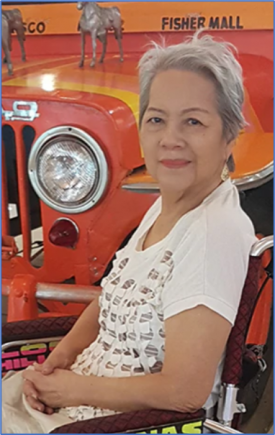by Fernando Zialcita y Nakpil
 Although Gilda would bounce me, as a baby, on her knee, my earliest memory of her was as a kid of eight or nine accompanying my mother to visit Gilda’s mother, Tita Nene, at their apartment on San Marcelino, Malate. Most likely my mother went there as well to buy one of Tita Nene’s famous cakes. The Nakpils and the Corderos became good friends as neighbors in Quiapo in the 1930s. The Corderos had a house almost in front of the Nakpil house. While ours was along the length of Calle Barbosa (now A. Bautista), theirs stood at the corner of Barbosa and Escaldo. According to my mom, little Gilda, with her two braided and beribboned pigtails swinging in the wind, would run across the narrow street to play with Nakpils her age. The house made a deep impression on her, as we shall see.
Although Gilda would bounce me, as a baby, on her knee, my earliest memory of her was as a kid of eight or nine accompanying my mother to visit Gilda’s mother, Tita Nene, at their apartment on San Marcelino, Malate. Most likely my mother went there as well to buy one of Tita Nene’s famous cakes. The Nakpils and the Corderos became good friends as neighbors in Quiapo in the 1930s. The Corderos had a house almost in front of the Nakpil house. While ours was along the length of Calle Barbosa (now A. Bautista), theirs stood at the corner of Barbosa and Escaldo. According to my mom, little Gilda, with her two braided and beribboned pigtails swinging in the wind, would run across the narrow street to play with Nakpils her age. The house made a deep impression on her, as we shall see.
When we visited Gilda and her Mom, she was a young lady in the uniform of Sta. Theresa College – navy blue skirt, white long-sleeved blouse and a big soft ribbon hanging from the collar, also in navy blue. She entertained me by playing on the piano and singing snatches from a popular song – Baka maputikan (Your clogs might get soiled):
Bukit ay basa,
Tag-ulan noon,
May isang mutya…
(The fields were wet,
The rains had come,
There was this entrancing lass…).
I would look up and gaze at her gentle eyes and those lips that, while seeming to pout, often relaxed into a warm smile. Gilda became a famous short story writer whose stories were collected into a book The Butcher, the Baker and the Candlestick maker – copies of which she sent to her Nakpil friends. She also became well-known as an essayist who regularly wrote short, easy to read essays for the magazines. Sometimes, to my delight, they reminisced about Pagsanjan (her father’s hometown), Malabon (her mother’s), and the Nakpils. I do not now remember what she wrote about my family, but years later she told me that she loved its flavors — homemade ice cream churned from carabao milk with plenty of egg yolks mixed into it, and fragrant with fresh coffee. And its scents – Lola Manggoy (Petrona Nakpil vda.de Bautista) may have been a “tiny” woman, but she always exuded a lavender scent especially after her daily bath. And its sounds – on evenings, melodies by someone playing the piano, while a violin wailed, sailed across the narrow street to the Cordero residence.
From time to time, Gilda’s path and mine would accidentally cross each other.”Kumusta? How’s your family?” Our paths would definitely meet when, as a young man in my late 20s, I went to the office of the illustrated encyclopedia-in-the-making, Filipino Heritage, and asked its editorin-chief Alfredo Roces if there still were articles I could write. He referred me to Gilda! She was one of the associate editors. She gave me a list of topics to look into. I dutifully wrote on each of them and submitted the drafts. Gilda’s reaction was, “I like your writing style.” That was praise indeed coming from a master of prose.
I left for Honolulu in 1973 to do my MA in Anthropology, then my Ph.D. in Anthropology. I came back four years later. During that period, Gilda became the publisher of books on the Philippines 2 2 that were so beautifully crafted that collectors bought them to display on their coffee tables. Her boldness amazed me, she was producing and selling prestige items at a time when the economy was stalling because a greedy dictator and his cronies were invading legitimate businesses and compelling their owners to partner, or else. Gilda was successful despite the lack of political backing.
I came back in 1977 ready to do fieldwork with my newly learned Ilocano among farmers in faraway Ilocos Norte. I wanted to know what forms of solidarity existed among them that they themselves could use for local development. My mom told me, “Gilda has been calling. She wants you to see her.” At her shop in Ermita, she told me, “Buching, I want you to write an entire book on houses like the one you grew up in Quiapo.” Was I stunned! For years, before taking a siesta or sleeping at night, I would quiet down by imagining myself in a house like ours with plenty of large, airy windows and cool, wooden floors where I could roll out a straw mat. “Yes, of course!” I also had another agenda. I was convinced from travels in Spain and Mexico, that we had developed our own urban style. It was very wrong and very alienating to call these houses “Spanish.” They were as Filipino as the straw mat rolled out on the wooden floor. Now I could share my ideas about these houses in a visually attractive book.
My stay in two rural barrios proved not to be a hurdle. Although I was trying to understand solidarity as expressed by farmers in their associations, whether informal or formal. I could not help but discover continuities between the way they used house space and the way it was used in the big urban houses. Moreover, from time to time I had to go on errands to Laoag which had streets full of 19th century houses. I liked poking around in the ruins of some to figure out how they were put together. And Vigan was just two hours away from Laoag. Once in a while I would take a break and visit my parents and my fiancée Gail Yoshikawa who had flown in from Honolulu. During those brief visits, Gilda would organize sorties to houses in Pampanga and Bulacan together with my co-author Sonny Tinio and our photographer Neal Oshima.
My fiancée and I planned our wedding. Of course there was only possible one choice for the godmother!
By late 1978, my fieldwork had ended. Although much of the book had been conceptualized in my mind, chapter by chapter, I would have to leave for Honolulu without submitting a final manuscript. However, surprisingly – or miraculously – the Immigration Officer at the US Embassy urged me to postpone my departure. Let my wife go ahead and petition for me after one year as a permanent resident. So my wife had to go ahead! However, this did give me time to finally finish the book. It was exhilarating working with Gilda, Cora Alvina her book manager, Nik Ricio the book designer, and Sonny Tinio. We planned the look of every single page! Finally Philippine Ancestral Houses 1810-1930 was launched in 1980. It was a success! Gilda told me it became her best seller, and has since gone into several printings during the past forty years. Even today people clamor for a copy and will pay a huge sum for a rare find. Two male physicians told me that before going to bed at night, they read a paragraph of the book for relaxation. It has become their bedtime story!
After teaching for a semester at the Ateneo, I left for Honolulu and would return only in June 1987. Gilda’s nationalism, always very sensory, became increasingly political. It was always fun visiting Gilda because of her love for things Philippine. One day, I would see a painted screen from Sulu that she had just bought, on another day she would bring me to a new native restaurant she had discovered in the province. But after the brutal assassination of Sen. Benigno Aquino Jr. in broad daylight at the International Airport, Gilda brought in her artistic skills in organizing demos, like one in front of Marcos’ major patron, the US Embassy, that were 3 3 satirical and funny. She was there at EDSA in February 1986, “trying to smile”, she told me, as she offered flowers to the soldiers in tanks sent to crush the huge four-day demonstration.
After I returned in June 1987, I resumed teaching at the Ateneo and working with Gilda on her other books. I thoroughly enjoyed Soul Book: An introduction to Philippine pagan religion. We were three authors, Gilda who did most of the research in Ateneo’s library, Francisco Demetrio SJ, and myself. Fr. Demetrio had been my teacher during the two years of Latin that was then obligatory at the Ateneo for those pursuing a Bachelor of Arts (in addition to the four years of Latin in a Jesuit high school). A Classics specialist, he decided it was time to look into our own myths and legends. Perfect! As a teenager, I lamented knowing more about the gods of Greece and Rome than about the diwatas of our islands. I collected the weekly columns of Armando Malay on Filipino legends into a scrapbook. Our artist was Roberto Feleo who did evocative black-and-white drawings. But the Filipino public was not ready for the book. For how indeed can you enjoy your merienda of cream-topped strawberry cake and coffee while looking at a black-and-white drawing of a Bukidnon god with many heads? Today, however, the mood has changed. Many Filipinos now regard the pagan as part of their identity. The book revealed another Gilda. At the novena for a recently departed relative, according to my mother, while the saints of the Catholic Church were invoked, Gilda called out the names of our native gods and goddesses!
Gilda’s interest in publications tapered somewhat after she discovered that she loved to paint, while at the same time writing essays again for publication. We saw less of each other, though sometimes friends and I had dinner with her. Arch. Ning Encarnacion-Tan enjoyed hosting some of these dinners.
Annually the Ateneo de Manila University confers a Tanglaw ng Lahi (Light of the Race) Award on individuals who have contributed substantially to Philippine arts and letters. I have sat in the selection committee for years. In 2008, Gilda’s name came up. The vote was unanimous. On the day itself, Gilda arrived in a white kimona blouse and a billowing floor-length russet skirt in plaids. When she lifted her skirt to mount the stage, guess what she wore as shoes? Glossy boxer’s shoes! Demure Filipiniana with in-your-face Pop! Only she could get away with an outrageous lesson on how to update tradition. This is how I want to remember her: radiant, wacky for a purpose, but always deeply rooted. “May isang Mutya…”
t
